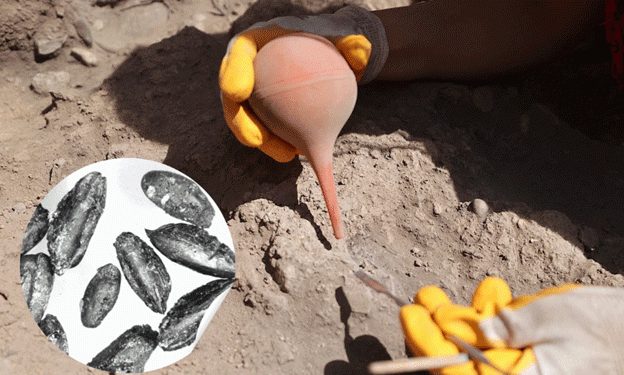At Yumuktepe Hoyuk, one of Türkiye’s oldest and most historically significant archaeological sites, researchers have made an extraordinary discovery: wheat seeds dating back nearly 9,000 years. These findings, uncovered during recent excavations led by associate professor Burhan Ulas from Inonu University, offer a window into the early agricultural practices of the Neolithic era and the pivotal role the Eastern Mediterranean played in the spread of farming to Europe.
The wheat varieties discovered—Triticum timopheevii and Triticum spelta—are two of the earliest known forms of wheat. While Triticum spelta is recognized as the most primitive form of bread wheat, Triticum timopheevii, also known as a “new type spa” wheat, is extremely rare today and cultivated only in a small region of Georgia. Through the use of “ancient DNA” analysis, the research team has been able to confirm the identity of these species, dating them to the Neolithic period, roughly 7,000–8,000 B.C.
Yumuktepe Hoyuk, located in Mersin, Türkiye, has been the focus of archaeological research since 1937. The site contains layers of historical significance, spanning from the Neolithic to the Medieval period, and offers valuable insights into the evolution of early human civilizations. According to Ulas, who also coordinates the ongoing excavations, the site is critical in understanding the spread of Neolithic agriculture through both land and sea routes from the Eastern Mediterranean to Europe.
“This discovery helps us reframe the role Yumuktepe played in disseminating Neolithic agricultural practices across continents,” said Ulas. He noted that the seeds found at the site provide concrete evidence of early wheat cultivation, challenging the belief that certain wheat types, like Triticum spelta, were first grown only during the Bronze Age. In fact, the research shows that Triticum spelta was cultivated nearly 3,000 to 4,000 years earlier than previously thought.
The significance of these findings is vast. Not only do they reshape our understanding of early agricultural timelines, but they also underscore the fragility of ancient wheat species, many of which are nearing extinction today. Triticum timopheevii, for instance, is now confined to a limited geographical area and is not widely cultivated for commercial use. Similarly, Triticum spelta, though it played a foundational role in early bread-making, has no modern agricultural application, further emphasizing the need to protect these ancient species from extinction.
The excavation work at Yumuktepe Hoyuk is part of Türkiye’s “Heritage for the Future” project, spearheaded by the Ministry of Culture and Tourism. Through this initiative, archaeologists are not only uncovering the agricultural history of ancient civilizations but also working to preserve these findings for future generations. The research team, consisting of 10 members, is currently analyzing carbonized plant remains from various periods, including the Neolithic, Chalcolithic, and Byzantine eras.
In conclusion, the wheat varieties uncovered at Yumuktepe Hoyuk offer a rare glimpse into the agricultural practices of our ancestors, reshaping our understanding of early wheat cultivation and the spread of farming throughout Europe. These findings highlight the importance of archaeological research in preserving and understanding our agricultural heritage.
Error





